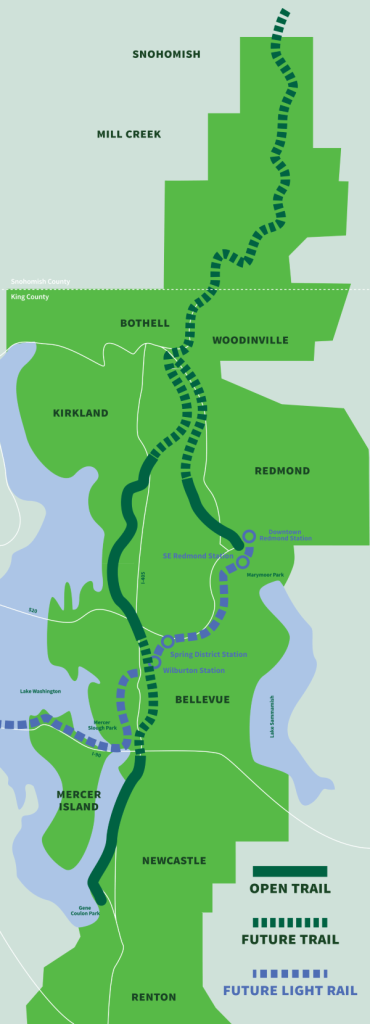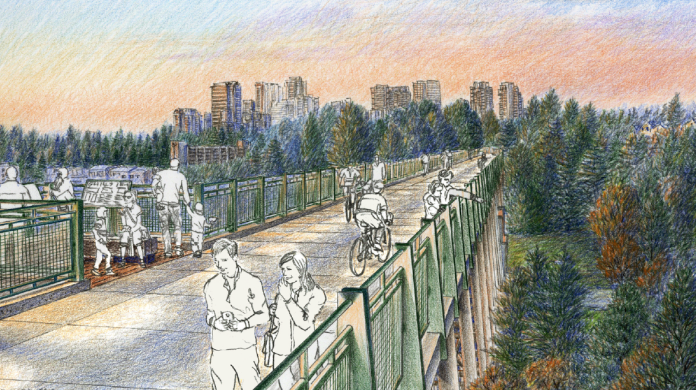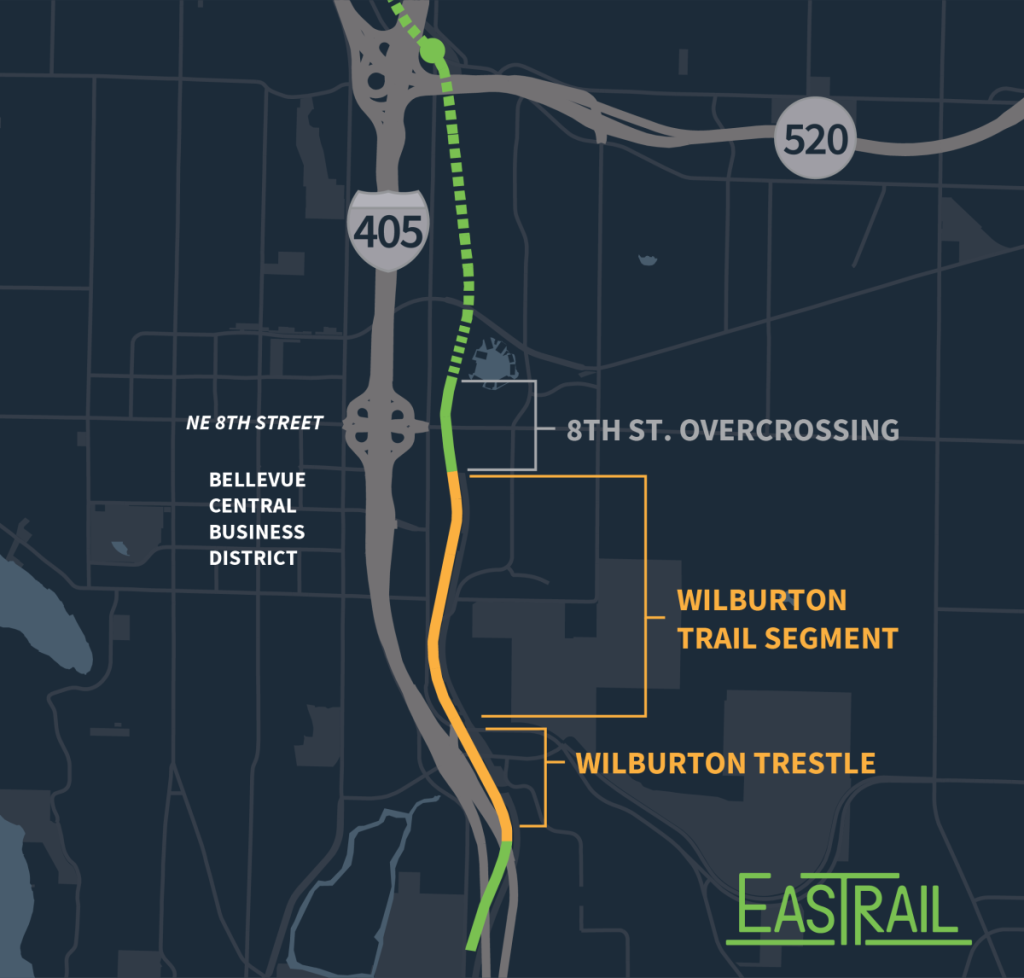Tech giant Amazon is partnering with King County to fund completion of the Wilburton and Wilburton Trestle trail segments in Bellevue, contributing $7.5 million to the projects. The trail segments stretch from the NE 8th Street Eastrail overcrossing to the I-405 Eastrail crossing. Collectively, the trail segments are a key part of the Eastrail program because they will tie central and southern portions of the trail together. When all is said and done, the Eastrail is slated to offer 43 miles of continuous trail from Renton to the Snohomish County line.
“Amazon’s contribution puts us over the top, providing the remaining funds we need to restore and transform the iconic Wilburton Trestle into an elevated trail connected to high-capacity transit,” said Executive Constantine. “The successful partnership to add the century-old trestle to our growing regional trail network shows that we are most effective when we mobilize the efforts of public and private sectors to achieve shared goals.”
Conversion of a former railway to trail doesn’t come cheaply, especially for a 102-foot tall, 975-foot long wooden railway trestle built in 1904. Estimates peg conversion of the trestle at $32 million alone. Amazon’s $7.5 million contribution will fund $5 million for the trestle conversion and $2.5 million for the remaining Wilburton segment. Other funding that has supported Eastrail include Kaiser Permanente, City of Bellevue, United States Department of Transportation, Washington State Washington, and King County. REI, Inc. and Facebook also contributed $2 million to connect the SR-520 Trail and Eastrail.
King County expects that the Wilburton and Wilburton Trestle segments will be completed in 2024. This will follow the 2023 opening of the Sound Transit’s 2 Line, which will deliver four light rail stations connecting with or in close proximity to the trail. Those stations include the South Bellevue, Bellevue Downtown, Wilburton, and Spring District/120th Stations. People walking, biking, and rolling on the trail will be able to make good connections to transit or get between home and destinations.

So far, Eastrail segments have been opened between Slater Avenue NE in Kirkland and the Spring District at 120th Avenue NE in Bellevue as well as from I-90 in Bellevue to Gene Coulon Park in Renton. A spur for the Redmond Central Connector Trail has also opened between 9,800 Block of Willows Road and Downtown Redmond. The trail segments are mix of soft surface gravel and pavement.
This fall, King County and Washington State Department of Transportation expect to open another 2.5 miles of paved Eastrail between Renton and Bellevue. This is a bit delayed beyond the May target that was pegged earlier this year. Trail users are temporarily being pushed onto the Lake Washington Trail, which involves in-street segments. Critical next segments will be the NE 8th Street overcrossing (2022) and I-405 crossing (2023) in Bellevue, Totem Lake Connector (2022) in Kirkland, Woodinville connection (2021/2022), and Redmond Central Connector Phase III (2024). A crown jewel to all of this in Bellevue will be when the city opens the Grand Connection over I-405 between Wilburton and Downtown Bellevue though no date has been identified for completion.
As far as the regional trail network goes, Eastrail will tie a multitude of trails together. Some of them include the I-90, Mountains to Sound, SR-520, Sammamish River, Lake to Lake, and Lake Washington Trails.
Eastrail Partners, an advocacy organization focused Eastrail program, lent commendations similar to Executive Constantine for the Amazon investment. “This exceptional trail opportunity requires exceptional community, governmental, and private sector support,” said Katherine Hollis, Executive Director of Eastrail Partners. “This leadership investment by Amazon demonstrates the important role business can play in the multifaceted Eastrail effort.” Amazon holds a leadership role in the organization.
Over the past couple years, Amazon has been rapidly building up a presence in Downtown Bellevue. The company said it has 10,000 corporate jobs in Bellevue and plans to increase that to 25,000 employees in five years. While Amazon has been leasing office space and plans to snap up more, the company also plans to occupy two towers — one 43 stories and another 27 stories — that it owns right across from Bellevue Downtown Station. Amazon employees who work in Seattle also live in Bellevue. So the investment in Eastrail does make economic sense for the company in providing a healthy, safe way for employees to get to and from work or recreate after — perhaps aiding in their employee recruitment efforts as well.
Leaders from Amazon and Bellevue have suggested the two have a more collaborative relationship compared to Seattle. Amazon has feuded with the Seattle City Council over efforts to tax the company and spent more than $1.5 million in the 2019 election trying to unseat incumbent city ouncilmembers to no avail. The result was JumpStart Seattle, a progressive tax on corporate payroll that was much larger than the head tax proposal that had so inflamed company executives in 2018. Bellevue has tried to capitalize on those tensions to woo Amazon jobs away from Seattle, but may run in similar constraints due a lack of housing affordability and a likelihood that corporate philanthropy alone won’t be sufficient to address affordable housing and infrastructure needs.
Stephen is a professional urban planner in Puget Sound with a passion for sustainable, livable, and diverse cities. He is especially interested in how policies, regulations, and programs can promote positive outcomes for communities. With stints in great cities like Bellingham and Cork, Stephen currently lives in Seattle. He primarily covers land use and transportation issues and has been with The Urbanist since 2014.



